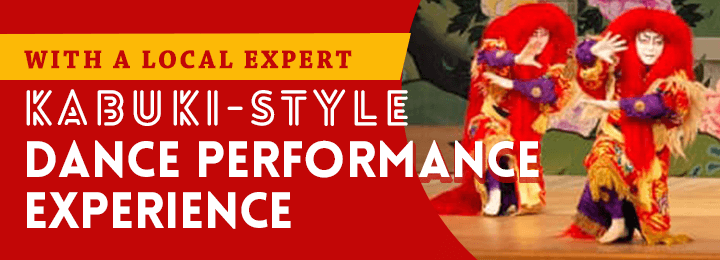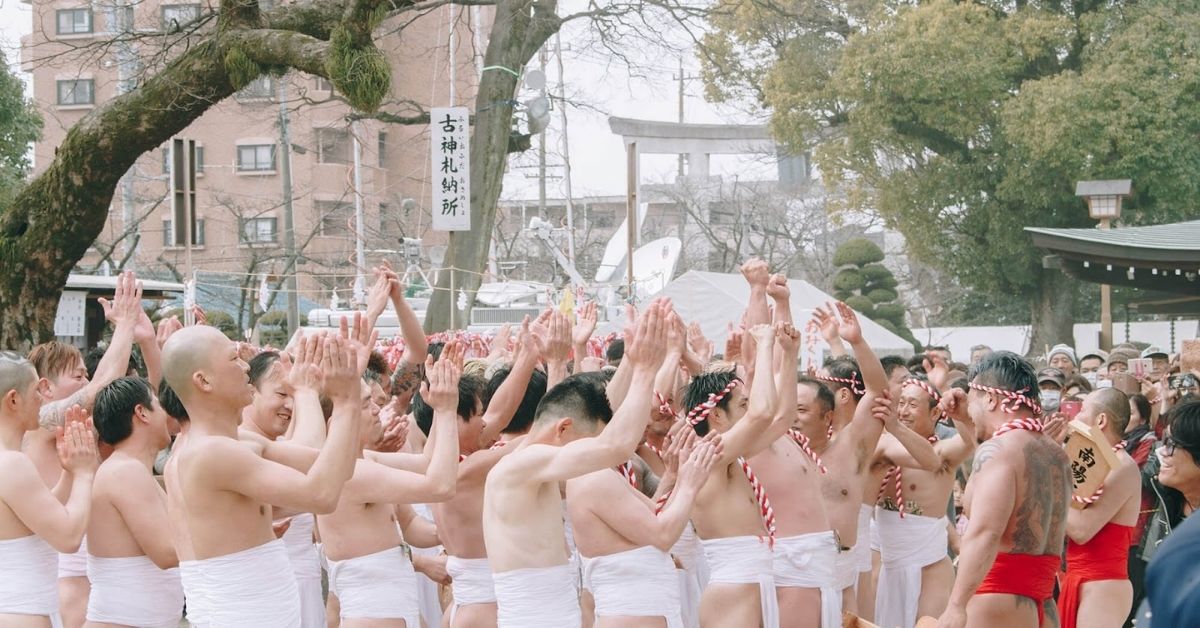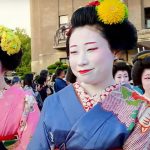Every year in autumn, the Nishikawa Ryu, one of the most influential traditional dance schools in Japan, puts on a colorful show called the Nagoya Odori (Nagoya Dance). At the Nagoya Odori, you can enjoy the impressive visual art and impeccable choreography of classic Japanese dances, as well as traditional Japanese tales in the form of a stage performance.
Article Contents
Kabuki, Nihon Buyo, and Odori – How They are Related

Odori, which translates to ‘dance’ in Japanese, refers in Nihon Buyo, a traditional dance style closely related to and often seen in Kabuki theater. To understand this type of dance we have to go back to the origins of Kabuki itself.
At the beginning of the 17th century, a priestess by the name of Izumo no Okuni would perform dances and funny parodies of Buddhist monks in the dry river bed of Kyoto for passers-by. It was enjoyed by the common people and quickly became a popular form of entertainment performed exclusively by women.

Her performances, full of drama and comedy, were beloved among the people. These representations are known as “Onna Kabuki”, where singing and dancing were interpreted in a very stylized way. Onna Kabuki was mix of music, dance, mime, and featured spectacular staging and costumes.
Over time, Japanese courtesans began to use this type of dance in their businesses to attract customers. Eventually, this practice brought about the downfall of Kabuki. Women were banned by the government from performing Kabuki. Soon after, female actresses were replaced by young male actors. Eventually these young men were also banned from performing because of problems of prostitution and moral corruption. This left only older men to act, even in the roles of women. This is the form of Kabuki that has persisted to the present day.
For more information, please check out this short TED talk about the history of Kabuki.
Nihon Buyo is a mixture of dance and pantomime. The history of Nihon Buyo begins with the two styles of traditional dances, Mai and Odori. These styles of dance appeared in the early Edo Period (1603 -1868) in the form of Kabuki dances (Kabuki Buyo). They were influenced by Bunraku (puppet theater) and Noh (a dance with masks more oriented to the aristocracy), and folk dance.
Although the term Nihon Buyo means “Japanese dance”, it does not refer to Japanese dance in general but refers to Kabuki-style dance performed in theater, and refined dance interpreted in small rooms or small spaces, generally carried out by Geisha.
Establishment of the Nagoya Odori

The Nishikawa Ryu is a classical dance company established in 1700 that specializes in teaching and performing Nihon Buyo. It was established in Nagoya and gradually spread all over Japan. The school continues to protect tradition while keeping up-to-date with the modern era.
In 1945, after the end of the Second World War, Nagoya was in ruins. The government asked Koisaburo Nishikawa II, then headmaster of the Nishikawa Ryu School of Dance, to create something to encourage people by bringing hope and happiness to everyone’s difficult lives. He created a festival that would last three days which he called “Nagoya Odori”.
Nagoya Odori is a collection of traditional dances from Noh, Kyogen (traditional Japanese comic theater), Kabuki, and Odori, and every year new original pieces are introduced. These pieces feature stars from different styles of theater and dance. Movie and television stars are also invited to perform.
Since then, Nagoya Odori has been performed every year in autumn in Nagoya. Its popularity has grown so much that one year, it was performed for 21 consecutive days!
A New Kind of Performance: Nagoya Odori Neo

Nagoya Odori was given an exciting reboot in 2022 called “Nagoya Odori Neo”. Starting in 2022, the festival took a step away from the traditional Nihon Buyo performances of the past in favor of a more modern interpretation. 2022’s performance featured a collaboration with a local idol group and a Takarazuka (Japan’s most popular women-only musical theater company).
In 2024, the Nagoya Odori returns with two captivating performances. The Classic show highlights traditional dances inspired by classical plays, while Neo offers a modern twist. The first part of Neo, the “National Geisha Expo,” gathers Geisha from across Japan to showcase their exquisite dances and performances. The second part is called NEO Dance Drama Nagoya Haikara Kagekidan. This new featured performance is advertised as “a Nagoya Odori-style musical that mixes fact and fiction, filled with laughs and emotion!” This show features contemporary dancers, idols, and Nishikawa School dancers and is a show you won’t want to miss.
This event will be held during the same weekend as the Nagoya Festival, another important cultural event. These events take place in Nagoya every year, and this year they will offer a total of four performances on the 19th and 20th of October at the Civic Assembly Hall at Tsuruma Park.

Other highlights of the Nagoya Odori Neo venue will be a Geisha parade at 16:00 as well as Yatai (festival food stalls) bringing the festive autumn atmosphere closer.
At the same venue, you can also find a showroom where you can purchase local arts and crafts, gifts, and local artisanal food and drink to enjoy at home.
Know Before You Go
For an unforgettable experience, we highly recommend booking our limited-time event: Geisha and Kabuki-Style Dance Performance in Nagoya. Spots are limited, so be sure to secure your booking by October 17th, 2024.

Nagoya Odori Neo (名古屋をどりNEO)
Dates: October 19th and 20th 2024, 11:00-14:00 and 17:00-20:00
Entry Fee: between 5500 and 11000 yen (Tickets sold here)
Address: Nagoya Civic Assembly Hall, 1-1-3 Tsurumai, Showa Ward, Nagoya, Aichi 466-0064
Access: From Nagoya Station take the JR Tokaido Line until Tsurumai Station. From here it’s a 3-minute walk.
Website | Google Maps
This post was last updated in August 2024.
Although we strive to provide you with the most accurate and up-to-date information possible, please note that changes may occur nonetheless. We recommend you confirm any relevant information such as event cancellations, changes, opening hours, or possible restrictions using a direct source. Please keep in mind that these sources might be in Japanese only.
Did you enjoy this article?
Would you want to experience the Nagoya Odori? Let us know in the comments!
Check out our other posts about Nagoya, and trust us when we say Nagoya is not boring! You may also be interested on our post about Nagoya’s Geishas.
Tag us 📲
If you have been to the Nagoya Odori or any other dance performance in Nagoya, please share your memories and tag us on social media with #nagoyaisnotboring
Be sure to follow us on Facebook for new articles every week and Instagram for pictures and stories of Nagoya!









